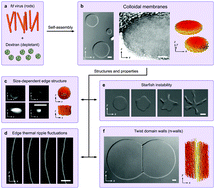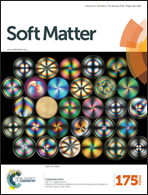Entropic forces stabilize diverse emergent structures in colloidal membranes
Abstract
The depletion interaction mediated by non-adsorbing polymers promotes condensation and assembly of repulsive colloidal particles into diverse higher-order structures and materials. One example, with particularly rich emergent behaviors, is the formation of two-dimensional colloidal membranes from a suspension of filamentous fd viruses, which act as rods with effective repulsive interactions, and dextran, which acts as a condensing, depletion-inducing agent. Colloidal membranes exhibit chiral twist even when the constituent virus mixture lacks macroscopic chirality, change from a circular shape to a striking starfish shape upon changing the chirality of constituent rods, and partially coalesce via domain walls through which the viruses twist by 180°. We formulate an entropically-motivated theory that can quantitatively explain these experimental structures and measurements, both previously published and newly performed, over a wide range of experimental conditions. Our results elucidate how entropy alone, manifested through the viruses as Frank elastic energy and through the depletants as an effective surface tension, drives the formation and behavior of these diverse structures. Our generalizable principles propose the existence of analogous effects in molecular membranes and can be exploited in the design of reconfigurable colloidal structures.



 Please wait while we load your content...
Please wait while we load your content...